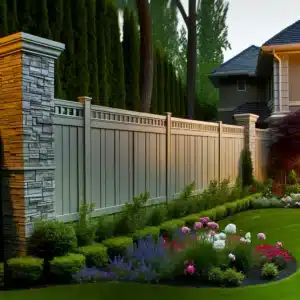At a Glance
- Importance of Railings for Safety at Home
- Safety Benefits of Railings in Public Places
- Railings for Safety in Commercial and Industrial Settings
- Design and Aesthetics of Railings for Safety
- Railing Safety FAQs
In the hustle and bustle of daily life, we often forget to pause and consider one fundamental aspect that allows us to enjoy our routines without fear – safety. It’s akin to a silent guardian, always present but seldom acknowledged. Imagine a day where you didn’t have to worry about slipping on the stairs or tumbling over the edge of a terrace. Yes, that’s the tranquility safety bestows upon us.
Railings, not often the star of the show, play an understated yet pivotal role in safeguarding our lives. They serve as barriers, preventing us from straying too close to danger. Whether it’s on a staircase, a balcony, or around a swimming pool, railings provide a protective shield that keeps accidents at bay.
Safety doesn’t just happen; it’s the result of careful planning and deliberate actions. Each element in our surroundings contributes to this collective sense of security. And today, we’ll focus on one such unsung hero that silently protects us from harm – railings.
Understanding Safety Railings
Railings are structures consisting of a series of bars or panels, usually supported by posts, installed along the edge of staircases, balconies, terraces, and other elevated areas. But they aren’t merely decorative additions. They have a dual purpose: to prevent accidental falls and to provide support for individuals navigating these spaces.
Railings come in various designs, with each type serving a unique purpose. Guardrail systems, often seen along roadways or rooftops, protect against fall hazards. Handrails are commonly found on staircases and ramps, providing support and stability. Deck railings, typically used on balconies or terraces, combine the features of guardrails and handrails to offer comprehensive safety.
The choice of material for a railing significantly influences its durability and maintenance needs. Wood, while aesthetically pleasing, requires regular upkeep to prevent decay. Metal railings, such as those made from steel or aluminum, are known for their strength and longevity. Glass railings, on the other hand, offer unobstructed views but may need frequent cleaning.
Learn more: The Environmental Benefits Of Wrought Metal Fencing
Importance of Railings for Safety at Home
Protecting Children and the Elderly
Railings act as a protective barrier for those most vulnerable to falls – children and the elderly. They provide something to hold onto, reducing the risk of slips and trips, especially near staircases or elevated areas.
Ensuring Safety on Stairs and Platforms
Staircases and platforms can become hotspots for accidents without proper safety measures. Here, railings serve as a physical guide, helping individuals navigate these spaces safely.
Securing Balconies and Terraces
Balconies and terraces are places where we seek relaxation, but they can also pose significant safety risks. Railings here serve as a line of defense, preventing anyone from accidentally falling over the edge.
Enhancing the Overall Security of the Property
Beyond their immediate safety benefits, railings also contribute to the overall security of a property. They act as deterrents, making it difficult for intruders to gain access, thus adding an extra layer of protection to homes.
Safety Benefits of Railings in Public Places
Promoting Crowd Control and Orderliness
Railings play a crucial role in managing crowd flow in public spaces, such as parks, stadiums, or event venues. They serve as physical barriers that guide people in the correct direction, preventing chaos and confusion. For instance, at concert venues, railings can be used to create separate lanes for entry and exit, ensuring an orderly movement of attendees. This organized flow of people minimizes the risk of stampedes or accidents that could occur due to overcrowding.
Preventing Accidents in Public Transport Stations and Platforms
In the context of public transportation, railings are indispensable safety features. They provide a protective barrier on platforms, especially those adjacent to train tracks or bus bays. By acting as a line of defense, railings prevent individuals from accidentally stepping or falling onto the tracks, thus averting potential accidents. Moreover, they also offer support for passengers who may be carrying heavy luggage or those who need stability while waiting for their transport.
Providing Support for People with Mobility Issues
Railings are especially beneficial for individuals with mobility issues, such as the elderly or people with disabilities. In public places like shopping malls, hospitals, or government buildings, railings installed along walkways, ramps, and staircases provide necessary support. They aid in balance and stability, making these spaces accessible and safe for all visitors.
Learn more: The Neighborly Way: Understanding Fence Etiquette
Railings for Safety in Commercial and Industrial Settings
Protecting Employees in Factories and Warehouses
In factories and warehouses, railings are essential for employee safety. They act as protective barriers around machinery, conveyor belts, or areas with a high risk of falls, like mezzanines or elevated platforms. Railings can prevent workers from accidentally coming into contact with moving parts or falling from heights, thus reducing workplace injuries.
Ensuring Safety on Construction Sites
On construction sites, safety railings are a must-have. They are typically installed around the perimeter of the site, along edges of roofs, and around open holes or excavations. These railings provide a visible, physical barrier that protects workers from fall hazards, one of the leading causes of fatalities in the construction industry.
Guidelines and Regulations Regarding Railings in Workplaces
There are specific guidelines and regulations, like those from the Occupational Safety and Health Administration (OSHA), that mandate the use of railings in commercial and industrial settings. Compliance with these rules is not only a legal obligation but also a demonstration of a company’s commitment to ensuring the safety and well-being of its employees.
Learn more: Tips To Consider When Choosing A Fence For Your Big Dog
Design and Aesthetics of Railings for Safety
Incorporating Style While Maintaining Functionality
While safety is the primary function of railings, it doesn’t mean they can’t be aesthetically pleasing. Many architects and designers skillfully incorporate railings into the overall design scheme, choosing materials and styles that complement the surroundings. Whether it’s sleek glass railings for a modern office or ornate wrought iron ones for a historic building, there’s a wide array of choices that can enhance both safety and visual appeal.
Various Railing Designs for Different Settings
Different settings call for different railing designs. For example, a hospital might opt for sturdy railings with smooth surfaces and rounded edges to prevent injury, while a beachfront property might choose rust-resistant railings with an open design that doesn’t obstruct the view. Understanding the specific needs and constraints of each setting is key to selecting the most suitable railing design.
Customization Options to Suit Individual Preferences
Finally, customization options allow for railings to be tailored to individual preferences and requirements. From the type of material and finish to the size and spacing of the balusters, every aspect can be customized. This ensures that the railings not only serve their primary function of ensuring safety but also align with the aesthetic vision and practical needs of the user.
Maintenance and Upkeep of Railings for Longevity and Safety
Regular Inspection and Repair of Damaged Railings
Regular inspection of railings is paramount in ensuring their longevity and safety. Over time, railings may develop signs of wear and tear due to constant use and exposure to various elements. This could be in the form of rust on metal railings, rot on wooden railings, or cracks on plastic ones. Identifying these issues early prevents them from escalating into more serious problems that could compromise the integrity of the railings.
Equally important is the timely repair of damaged railings. Neglected damage not only accelerates the deterioration of the railing but also poses a significant safety risk. For instance, a rusted metal railing could eventually break and result in a fall, while a rotten wooden railing might give way under pressure. Therefore, prompt repairs are crucial in maintaining the safety and longevity of railings.
Cleaning and Weatherproofing Railings
Another essential aspect of maintaining railings is regular cleaning. Dirt and grime can cause damage over time, especially when combined with moisture. For metal railings, this could lead to rust, while for wooden railings, it could lead to rot. Regular cleaning helps to prevent such damage and keeps the railings looking their best.
Weatherproofing is also an important part of railing maintenance. This involves the application of protective coatings to shield the railings from harmful environmental elements such as sun, rain, snow, and wind. For instance, metal railings can be coated with rust-resistant paint, while wooden railings can be treated with a waterproof sealant. By weatherproofing railings, their lifespan can be significantly extended, and their safety ensured.
Importance of Professional Installation and Maintenance Services
While some aspects of railing maintenance can be done by the homeowner, others require professional expertise. Installation of railings, for instance, should be done by professionals to ensure that they are securely fixed and capable of withstanding the required weight loads. Incorrect installation could result in unstable railings, posing a serious safety risk.
Similarly, certain maintenance tasks such as repairing structural damage or applying weatherproofing treatments are best left to professionals. They have the necessary knowledge, skills, and equipment to perform these tasks effectively and safely. By engaging professional installation and maintenance services, homeowners can have peace of mind knowing that their railings are in good hands.
Conclusion
Railings play an integral role in ensuring safety in our homes and public spaces. They provide support and prevent falls on stairs, balconies, decks, and other elevated platforms. However, for railings to effectively serve this purpose, they need to be well-maintained. Regular inspection and timely repair of damaged railings, coupled with routine cleaning and weatherproofing, are essential in maintaining their safety and longevity.
The safety benefits of railings cannot be overstated. As such, it is incumbent upon individuals and organizations to prioritize safety when installing and maintaining railings. This includes choosing durable materials, ensuring proper installation, and adhering to regular maintenance practices. By doing so, they can significantly reduce the risk of accidents and injuries associated with falls.
In conclusion, railings are more than just functional or aesthetic features; they are critical safety elements that contribute to personal well-being and public safety. Their importance should therefore not be overlooked. With proper installation and maintenance, railings can provide reliable safety for many years, protecting individuals from potential harm and enhancing the overall safety of our living and working environments.
Railing Safety FAQs
Why are Guardrails and Handrails Important?
Guardrails and handrails play an essential role in ensuring safety, particularly in preventing falls from elevated areas like balconies, decks, and stairs. They provide a secure grip and assist in maintaining balance, minimizing the risk of accidents.
What are the Different Types of Railings?
There are various types of railings, including wood, metal, glass, and cable railings. Each type has its pros and cons concerning aesthetics, maintenance, durability, and safety. For instance, glass railings offer unobstructed views but require regular cleaning.
Is Your Wood Split or Decaying?
Wooden railings, while aesthetically pleasing, may split or decay over time, posing a safety risk. Regular inspection for signs of deterioration is necessary, and damaged sections should be promptly replaced.
Do You Have Any Loose or Corroded Fasteners?
Loose or corroded fasteners can compromise the stability of your railing. It’s crucial to regularly check and tighten loose fasteners and replace corroded ones to maintain railing safety.
What Kind of Glass is the Strongest for Glass Stair Railings?
Tempered safety glass is often used for glass stair railings due to its superior strength. It’s four to five times stronger than standard glass, enhancing safety.
Is Railroad Safety Really an Issue These Days?
Yes, railroad safety remains a crucial issue. Railings around railroad tracks can help prevent accidents by keeping people at a safe distance.
Are Cable Railings Safe and Sleek?
Cable railings are not only sleek in design but also safe. They provide an unobstructed view while maintaining safety. However, they need to be properly installed and tensioned to ensure optimal safety.
How Can Stair Railing Child Safety be Ensured?
For homes with children, additional safety measures like installing gates at the top and bottom of the stairs can be beneficial. This helps keep children safe by preventing them from climbing or falling down the stairs.



